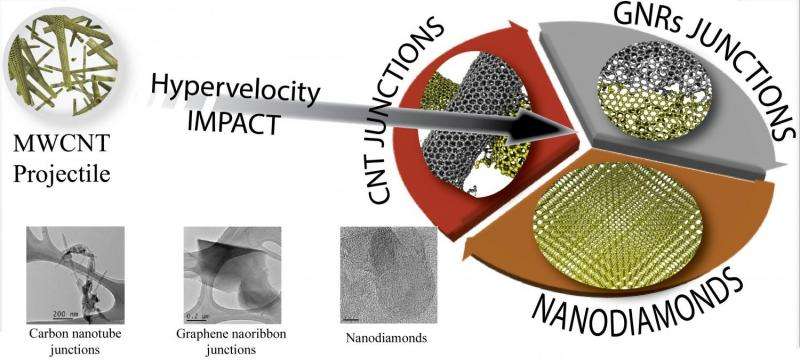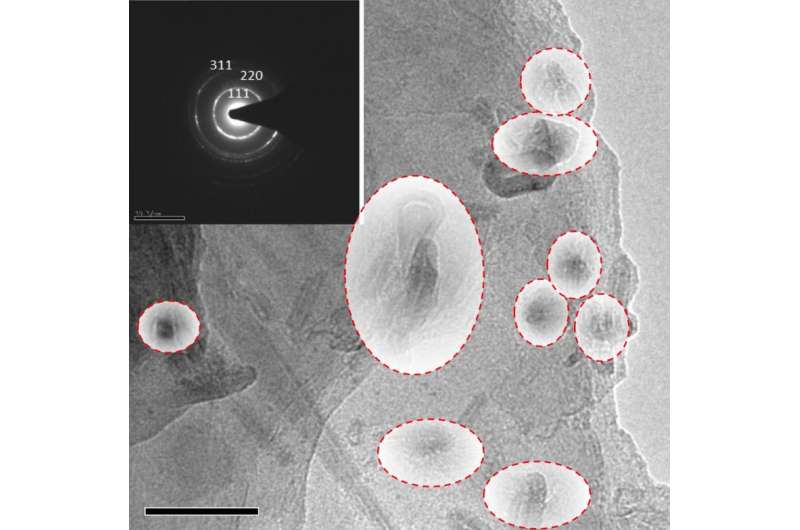Research team morphs nanotubes into tougher carbon for spacecraft, satellites

Superman can famously make a diamond by crushing a chunk of coal in his hand, but Rice University scientists are employing a different tactic.
Rice materials scientists are making nanodiamonds and other forms of carbon by smashing nanotubes against a target at high speeds. Nanodiamonds won't make anyone rich, but the process of making them will enrich the knowledge of engineers who design structures that resist damage from high-speed impacts.
The diamonds are the result of a detailed study on the ballistic fracturing of carbon nanotubes at different velocities. The results showed that such high-energy impacts caused atomic bonds in the nanotubes to break and sometimes recombine into different structures.
The work led by the labs of materials scientists Pulickel Ajayan at Rice and Douglas Galvao at the State University of Campinas, Brazil, is intended to help aerospace engineers design ultralight materials for spacecraft and satellites that can withstand impacts from high-velocity projectiles like micrometeorites.
The research appears in the American Chemical Society journal ACS Applied Materials and Interfaces.
Knowing how the atomic bonds of nanotubes can be recombined will give scientists clues to develop lightweight materials by rearranging those bonds, said co-lead author and Rice graduate student Sehmus Ozden.
"Satellites and spacecraft are at risk of various destructive projectiles, such as micrometeorites and orbital debris," Ozden said. "To avoid this kind of destructive damage, we need lightweight, flexible materials with extraordinary mechanical properties. Carbon nanotubes can offer a real solution."
The researchers packed multiwalled carbon nanotubes into spherical pellets and fired them at an aluminum target in a two-stage light-gas gun at Rice, and then analyzed the results from impacts at three different speeds.
At what the researchers considered a low velocity of 3.9 kilometers per second, a large number of nanotubes were found to remain intact. Some even survived higher velocity impacts of 5.2 kilometers per second. But very few were found among samples smashed at a hypervelocity of 6.9 kilometers per second. The researchers found that many, if not all, of the nanotubes split into nanoribbons, confirming earlier experiments.
Co-author Chandra Sekhar Tiwary, a Rice postdoctoral researcher, noted the few nanotubes and nanoribbons that survived the impact were often welded together, as observed in transmission electron microscope images.
"In our previous report, we showed that carbon nanotubes form graphene nanoribbons at hypervelocity impact," Tiwary said. "We were expecting to get welded carbon nanostructures, but we were surprised to observe nanodiamond as well."
The orientation of nanotubes both to each other and in relation to the target and the number of tube walls were as important to the final structures as the velocity, Ajayan said.
"The current work opens a new way to make nanosize materials using high-velocity impact," said co-lead author Leonardo Machado of the Brazil team.

More information: Sehmus Ozden et al. Ballistic Fracturing of Carbon Nanotubes, ACS Applied Materials & Interfaces (2016). DOI: 10.1021/acsami.6b07547
Journal information: ACS Applied Materials and Interfaces
Provided by Rice University





















